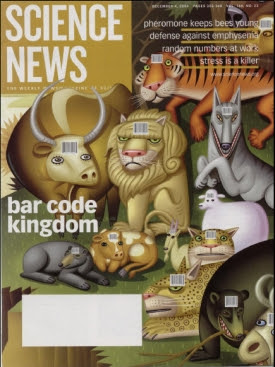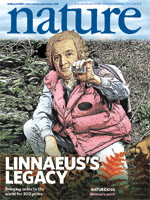In an earlier post, I expressed some frustration at the way discoveries about non-coding DNA are reported. I noted in particular ScienceDaily‘s description of the recent publication of the opossum genome sequence. In case you missed it, here it is again:
Opossum Genome Shows ‘Junk’ DNA Source Of Genetic Innovation
(…)
The research, released Wednesday (May 9) also illustrated a mechanism for those regulatory changes. It showed that an important source of genetic innovation comes from bits of DNA, called transposons, that make up roughly half of our genome and that were previously thought to be genetic “junk.”
The research shows that this so-called junk DNA is anything but, and that it instead can help drive evolution by moving between chromosomes, turning genes on and off in new ways.
(…)
It had been initially thought that most of a creature’s DNA was made up of protein-coding genes and that a relatively small part of the DNA was made up of regulatory portions that tell the rest when to turn on and off.
As studies of mammalian genomes advanced, however, it became apparent that that view was incorrect. The regulatory part of the genome was two to three times larger than the portion that actually held the instructions for individual proteins.
Since my post, National Geographic has gotten in on the act as well:
First Decoded Marsupial Genome Reveals “Junk DNA” Surprise
(…)
The study reveals a surprising role in human evolution for “jumping genes”—parasitic bits of “junk DNA” that until now were thought to be nothing more than a nuisance—and may also lead to a number of medical breakthroughs.
(…)
The scientists were also surprised to find that these regulatory sequences have in large part been distributed across the human genome by so-called jumping genes.
These genes have hopped through chromosomes for more than a billion years, leaving behind many copies of themselves. So until now the genes had been widely regarded by scientists as parasites, or “junk DNA,” that played no creative role in evolution.
You can consult my earlier posts for specific complaints on this. More generally, I have the following suggestions for science writers who are reporting on interesting findings about non-coding DNA.
1) Don’t assume that every new discovery is overthrowing some recalcitrant conventional wisdom.
If you want to claim that all scientists have long believed that all non-coding DNA is totally functionless, kindly point to a few examples. Here are a few cases that suggest that you may have a bit of trouble with this.
When Barbara McClintock first characterized transposable elements in 1950, she called them “controlling elements”. Comings (1972), who gave the first detailed discussion of “junk DNA” (his paper, unlike Ohno’s, was an explicit discussion of the topic of “junk DNA” and appeared in print before Ohno [1972], which he cites as “in press”), stated that “being junk doesn’t mean it is entirely useless.”
Orgel and Crick (1980), in their paper introducing the concept of “selfish DNA”, noted very clearly that:
It would be surprising if the host organism did not occasionally find some use for particular selfish DNA sequences, especially if there were many different sequences widely distributed over the chromosomes. One obvious use … would be for control purposes at one level or another. This seems more than plausible.
Doolittle and Sapienza (1980), whose paper appeared along with that of Orgel and Crick (1980), were equally unambiguous on the issue:
We do not deny that prokaryotic transposable elements or repetitive and unique-sequence DNAs not coding for proteins in eukaryotes may have roles of immediate phenotypic benefit to the organism. Nor do we deny roles for these elements in the evolutionary process. We do question the almost automatic invocation of such roles for DNAs whose function is not obvious, when another and perhaps simpler explanation for their origin and maintenance is possible.
2) Don’t imply, intimate, or suggest, directly or indirectly, that the discovery of function in some non-coding DNA sequences means that all non-coding DNA is functional.
Remember to implement the onion test if you are tempted to argue otherwise. Note that simply having “junk DNA found to be functional” as a headline with no qualification or clarification commits the fallacy as well. The last two examples of poor reporting (see here and here) have neglected to mention that the amount of non-coding DNA that was shown to be conserved and presumably functional is less than 5% of the genome. I imagine that a reader’s interpretation may change somewhat when this important detail is made clear.
I am as excited as anyone about new discoveries in genome biology. I have also been critical of the tendency to focus too much on protein-coding genes or simple allele frequency changes in evolutionary science (Gregory 2005). But it does not follow that every new finding is revolutionary in and of itself, nor is it the case that non-coding DNA has been dismissed as unimportant for decades and that its relevance is only now being admitted by stubborn academics. The commentaries of people like Comings, Ohno, Orgel and Crick, and Doolittle and Sapienza were made in response to an overemphasis on functional explanations for all non-coding DNA, but even they did not reject the potential importance of some non-coding elements.
There is a growing frustration among scientists relating to the unnecessary search for “balance“ in journalists’ reporting. What I see happening with non-coding DNA is the opposite of this, though equally problematic. To wit, many writers are painting a monochromatic picture of genome biologists when in fact there has always been a full spectrum of opinions regarding the importance of non-coding sequences. The material is exciting; it doesn’t need to be embellished with exaggerated controversy to be worth reading about.
___________
References
Comings, D.E. 1972. The structure and function of chromatin. Advances in Human Genetics 3: 237-431.
Doolittle, W.F. and C. Sapienza. 1980. Selfish genes, the phenotype paradigm and genome evolution. Nature 284: 601-603.
Gregory, T.R. 2005. Macroevolution and the genome. In The Evolution of the Genome (ed. T.R. Gregory), pp. 679-729. Elsevier, San Diego.
McClintock, B. 1950. The origin and behavior of mutable loci in maize. Proceedings of the National Academy of Sciences of the USA 36: 344-355.
Ohno, S. 1972. So much “junk” DNA in our genome. In Evolution of Genetic Systems (ed. H.H. Smith), pp. 366-370. Gordon and Breach, New York.
Orgel, L.E. and F.H.C. Crick. 1980. Selfish DNA: the ultimate parasite. Nature 284: 604-607.








